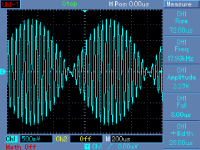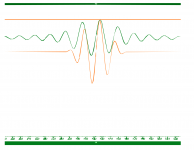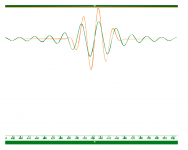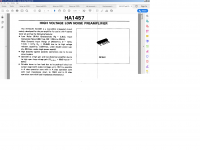I bough one and was going to use it until I saw all the I/O opamps were 741's.
THx-RNMarsh
yes, 2068. Thats the one. Bad choice of opamp.
Really bad opamp

● Operating Voltage ±4V~±18V
● Low Total Harmonic Distortion 0.001%
● Low Noise Voltage 0.56μV (FLAT+JISA)
● High Slew Rate 6V/μs
● Unity Gain Bandwidth 27MHz (f=10kHz)
Envelope yes (from heavy "Gibbs'ing" due to the steep filters), carrier no.
Top trace: brickwall filtered output (384-->44.1-->384 resampling)
Bottom trace: 5x20 input
The time period between peaks is different.
Why is that?
-RNM
It's overlayed, just in different plot panes. You may do a difference or overlay in any graphics editor (photoshop, gimp) if you feel so.Why are you not overlaying input signal and output signal?
Like the zero-crossing difference, it comes from the EQ (in form of the Brickwall).The time period between peaks is different.
Why is that?
It's overlayed, just in different plot panes. You may do a difference or overlay in any graphics editor (photoshop, gimp) if you feel so.
Cmon, you can do it..you can show us that the output signal is time spread with respect to the input signal..both the carrier and the envelope.
We all see it, it's obvious to the most casual of observers..
The real question is, why you are so opposed to showing us.
jn
The sum of the two frequencies show a 20Khz signal, amplitude modulated, and where it goes to zero modulation, sign inverts.
I suspect that complex waveform would never be confused with a pure sine.
jn
This is NOT any modulation!!!!!! This is a sum of 2 sines with beats at F2-F1!!
Attachments
This is NOT any modulation!!!!!! This is a sum of 2 sines with beats at F2-F1!!
Really?? We have to start at square one with you also??
Here's a link pic showing the result of two sines beating. Note the equation is the product of a sine and a cosine.
https://upload.wikimedia.org/wikipedia/commons/2/2e/Beating_Frequency.svg
That formula is the exact same thing shown on this next site. Scroll down a bit to the "truly obscure identities".
Summary of trigonometric identities
As I stated earlier, this is trigonometry. Something we learned in the 6th, 7th, or 8th grade. I can't remember, it was too long ago.
I suspect it was not 8th grade however...that was the best three years of my life, 8th grade..
john
Envelope yes (from heavy "Gibbs'ing" due to the steep filters), carrier no.
Top trace: brickwall filtered output (384-->44.1-->384 resampling)
Bottom trace: 5x20 input
Attachments
Last edited:
I’m sorry, but you didn’t even try Electroj files that he carefully prepared, or at least you didn’t mention it afaik.I had been told that Americans and English people were not jealous of the fortunes of others. An urban legend?
That said, think about it. You pay for the CD burning, the cover and the transports. It's free for downloadable files: less expensive..
I'm retired, not heeled at all, and want high definition files. Because it doesn't cost more, because I can always reduce its size and quality if I want. because more is better than just enough.
No one thinks of shaming you because you are satisfied with the little red book. Not my notion of democracy, whatever I find CDs quite satisfactory ... but not perfect.
it don't males a lot of difference if you enjoy music, more if you are a passionate audiophile. That is not a sin neither ;-)
As we say in France: "Butter plus the money of the butter and the smile of the creamery".
Any resemblance to "The last tango in Paris" would be pure coincidence.
As long as you haven’t reported your findings, your opinion is just an opinion but without reference. When you want to take the safe road with HD that’s fine, but stop telling that 44.1/16 is not perfect without coming with any prove.
Hans
Really bad opamp
● Operating Voltage ±4V~±18V
● Low Total Harmonic Distortion 0.001%
● Low Noise Voltage 0.56μV (FLAT+JISA)
● High Slew Rate 6V/μs
● Unity Gain Bandwidth 27MHz (f=10kHz)
Actually it is not too bad and can get it for 40 cents. Cheap and cheerful.
On the old data sheet i thought it said SR =.6 v/usec (a la 741-ish)
Its 6 v/us. Eh.
Needs an input HF filter.
-RNM
Last edited:
Really?? We have to start at square one with you also??
Here's a link pic showing the result of two sines beating. Note the equation is the product of a sine and a cosine.
Thank you for a new word, prosthaphaeresis. I will note the Fourier spectra of both sides of the equation must be the same. The right side is done by convolution (product) and since the difference between the sine and cos is simply a sign flip of the negative frequency there is cancellation leaving the same two original lines. There are no new frequencies via the trig argument.
BTW - I prefer Euler's formula for trig stuff.
Last edited:
ref #34809
and the period between peaks are also different.
That does not seem like what you want to have?
THx-RNMarsh
Last edited:
TNT, Thank you for posting the overlays.
The waveform referred to as the origninal 5x20 is not a continuously repeating waveform. Means the Fourier components that represent it are not exactly the same as for the continuous waveform we have been talking about.
To better intuit what is displayed in the overlays it might be helpful to display an FFT of the input waveform and an FFT of the resampled waveform.
The waveform referred to as the origninal 5x20 is not a continuously repeating waveform. Means the Fourier components that represent it are not exactly the same as for the continuous waveform we have been talking about.
To better intuit what is displayed in the overlays it might be helpful to display an FFT of the input waveform and an FFT of the resampled waveform.
Last edited:
The waveform referred to as the origninal 5x20 is not a continuously repeating waveform. Means the Fourier components that represent it are not exactly the same as for the continuous waveform we have been talking about.
To make sense out of what is happening it might be helpful to display an FFT of the input waveform and an FFT of the resampled waveform.
Well, isnt that more like music than a CW signal? Its exactly what we want... to see effect of 16/44 CD processing on transients etal. Thus, the Cymbal example.
THx-RNMarsh
Intermission time --- crank it up --- YouTube
Last edited:
#34814 and no Holly Grail yet...
Its a tough slog. You have any helpful explanations to offer?
none unfortunately ...Its a tough slog. You have any helpful explanations to offer?
Well, isnt that more like music than a CW signal?
More like music, yes. However as Scott Wurcer just pointed out, the visual appearance of a new frequency (the so-called carrier) does not mean there is really an actual frequency there. Its just two frequencies beating, not suddenly three frequencies. Doesn't matter if the eye/brain wants to call a pattern a frequency. It really not unlike seeing a face in something that isn't really a face, same type of shortcut-algorithm pattern-recognition which is subject to errors. With a waveform, one must look in the frequency domain to see what frequencies are really there, not eyeball it.
Now, if we don't care about frequencies and only care about time-domain waveforms, eyeballing might be a somewhat more reliable indicator. However, without knowing how humans hear, and the range of variation in that in a large population of humans, we can't know which domain is useful to look at for audibility. IMHO probably hearing involves processing that is similar to some combination of time and frequency domain views, but does so to different degrees under different listening conditions/circumstances. Unless we know what we should be looking for we will continue to get nowhere.
Last edited:
- Status
- Not open for further replies.
- Home
- Member Areas
- The Lounge
- John Curl's Blowtorch preamplifier part III



